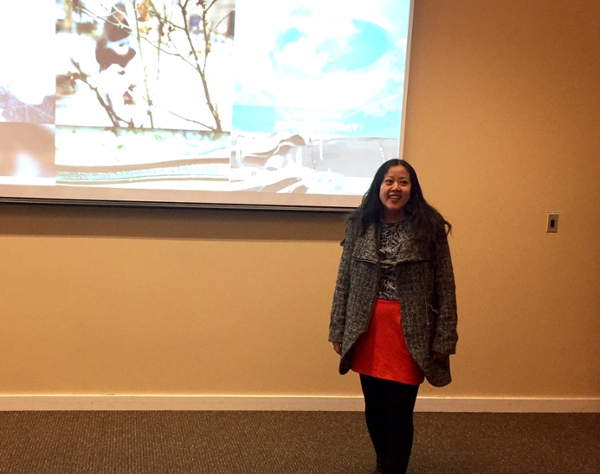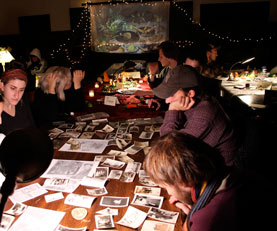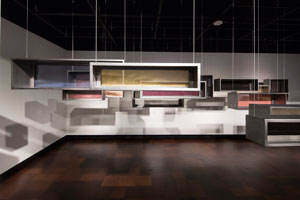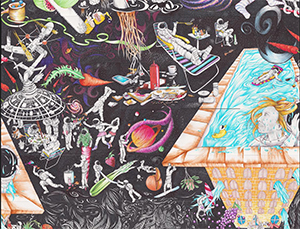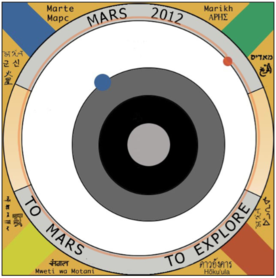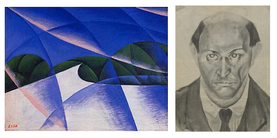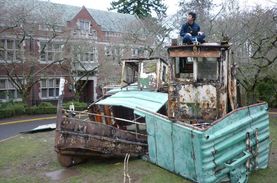
IRIS login | Reed College home Volume 96, No. 2: June 2017
Tags
"art"
RAW Edges Closer to the Borderline
If you happened to be walking through through New York City’s Chinatown one night last August, you might have noticed the words “Gentrification is modern colonialism” projected onto the wall of M.S. 131. You might have stopped and watched as they were replaced first with animations, then song lyrics, then, a question: “Who did you displace to open your gallery?”
Earlier that evening, the Chinatown Art Brigade—an arts collective dedicated to defending tenants from displacement—had parked a van rigged with equipment next to the school. That night, they projected messages about gentrification and community resilience onto the wall as part of their “Here to Stay” project.
Artist Betty Yu, one of the Brigade’s founders, visited Reed on March 4 to talk about “Resisting Gentrification through Art, Culture, and Activism” as part of Reed Arts Week. This year’s RAW curators, Charlie Perez ‘17 and Daphne Lyda ‘17, organized the five-day festival around the idea of borders.
Continue reading RAW Edges Closer to the Borderline
Art Major Nabs Udall Scholarship
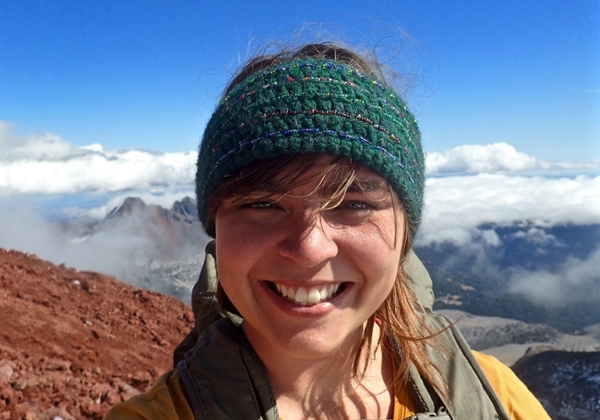
Studio art major Leila Pyle ’17 was recognized for her commitment to the environment, leadership potential, public service, and academic achievement.
Studio art major Leila Pyle ’17 has won a prestigious scholarship from the Udall Foundation recognizing her commitment to the environment, leadership potential, record of public service, and academic achievement.
The foundation’s announcement describes Leila as:
… passionate about environmental education and action through art. Both in her own work and in teaching others, she tries to communicate how the materials we use and the stories we tell through art can be used to generate a positive cultural relationship with the natural world. Leila also loves working with children and is an active Girl Scout leader. She attended the 2016 World Association of Girl Guides and Girl Scouts Helen Storrow Seminar as a representative of the United States. She gathers wonder from gardening, singing, hiking, and climbing trees.
Continue reading Art Major Nabs Udall Scholarship
“Zero Project” turns art gallery into airplane hangar
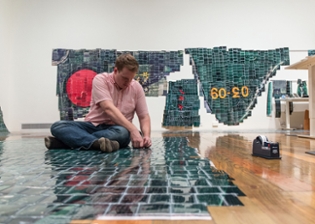
Reed students assemble the Zero Project by Katsushige Nakahashi in the Cooley Art Gallery. The project involves stitching together more than 25,000 individual photographs. Daniel Cronin
It’s an airplane. It’s a puzzle. It’s a work of art.
The monumental Zero Project is currently on display in Reed’s Douglas F. Cooley Memorial Gallery, transforming the gallery into a surreal airplane hangar where students are painstakingly stitching more than 25,000 individual photographs into a single gargantuan image.
Eschewing mimesis for collaborative assembly, Zero Project is the brainchild of artist Katsushige Nakahashi. As a boy, he played with a plastic scale model of the aircraft flown by Imperial Japanese Navy kamikaze pilots during WWII— the Mitsubishi A6M Zero warplane.
Continue reading “Zero Project” turns art gallery into airplane hangar
Reed Arts Week (RAW) 2015: <i>Might Now</i>
This year, Reed Arts Week (RAW), March 3–8, takes a turn for the understated and the peculiar, with the highlight of the opening exhibition being a fist-sized rock. The rock displays a smiley face on its surface, and its owner is attempting to sell it for $1 million on eBay, despite never having received a bid.
Other installations include a camera obscura inside Vollum lounge, which uses vibrations from Eliot Circle to create a subdued shadow world, and captures students walking to class in the form of indistinct silhouettes.
The Gray Campus Center features a “quiet room,” or traceless environment; the space is light and soundproof, completely cut off from the rest of campus. The intent of the room is to give students an experience of being entirely solitary, while still in the heart of campus. The sports center is home to the opposite effect, with an audio system set up in the racquetball courts that records the sound in the room and then plays it back a minute later, simultaneously with all of the sound that has been recorded previously. The cacophony will increase relentlessly throughout the week, resulting in a complete audio record of the room during RAW.
Continue reading Reed Arts Week (RAW) 2015: <i>Might Now</i>
<i>Shades of White:</i> Elegant, Geometrical, and Chilling
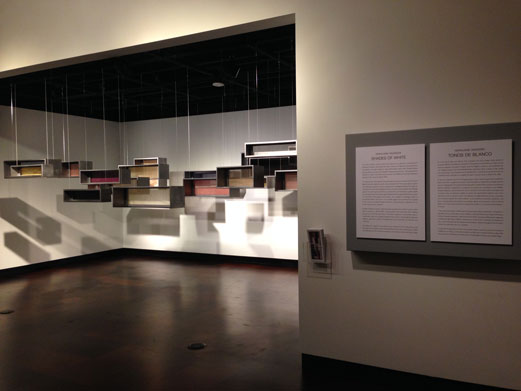
Prof. Ondrizek's "Shades of White" is a sobering meditation on social injustice. Courtesy of Geraldine Ondrizek
Prof. Geraldine Ondrizek’s thought-provoking exhibition, Shades of White, is as beautiful to look at as it is unsettling to think about. Dramatically installed in the Artist Project Space of the Jordan Schnitzer Museum of Art (University of Oregon), the show exudes minimalist cool: 24 steel boxes suspended from the ceiling by metal wires, each box backed with silk panels in muted hues. With its armada of suave, industrial rectangles seemingly floating midair, it looks like a long-lost Donald Judd installation that somehow wound up in a zero gravity chamber. But there is far more at play here than elegant geometry for its own sake; Prof. Ondrizek has created a sobering meditation on a social injustice perpetrated not only in Nazi Germany, but also in the United States.
Continue reading <i>Shades of White:</i> Elegant, Geometrical, and Chilling
Shades of White
The discredited science of eugenics served as inspiration for Shades of White, an installation by Prof. Geraldine Ondrizek [art 1994–] created for the Jordan Schnitzer Museum of Art at the University of Oregon. Prof. Ondrizek spent years researching the work of Alexandra Minna Stern, a medical historian at the University of Michigan and the author of Eugenic Nation: Faults and Frontiers of Better Breeding in Modern America.
Ondrizek’s investigation led to a visual reinterpretation of the “Gates Skin Color Charts” created by R. Ruggles Gates and used by eugenicists in the mid-20th century to assign an individual's racial category. Hand-dyed silk, displayed in 18-gauge steel boxes, approximates variations of skin pigmentation. “Her appropriation of this eugenic device to facilitate a discussion of human dignity is poignant and timely,” notes June Black, the museum’s associate curator.
Continue reading Shades of White
Jamie Isenstein ’98: The Lady Returns
Jamie Isenstein ’98, last seen on campus in 2011, inhabiting an armchair (The Lady Vanishes) returns to the Cooley Gallery for a public reception, beginning at 6 p.m. on Thursday, September 19, 2013. This mid-career survey is curated by gallery director Stephanie Snyder ’91, who admires Jamie's drawings, mixed-media sculptures, and installations as pieces that "engage the artist’s body as an artistic medium—a subject of humor, theatricality, and historical representation." A studio art major at Reed, Jamie became intrigued with Northern Renaissance art and considers her own work to be an update on many of the themes popular then, such as the Vanitas and Momento Mori. At Art Basel in 2011, she staged an "anti-concert" in which she spent two weeks weaving a rug onto a harp, compromising its strings and thereby removing music (dampening sound) vs. making music (video). You can see her at her harp once again on Thursday evening.
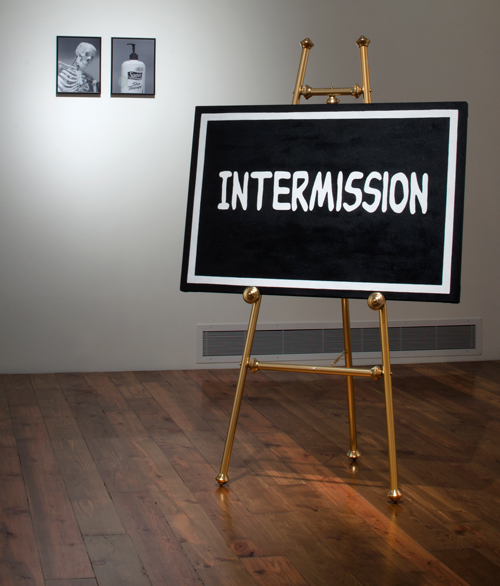 In an essay for the catalog of the exhibition, Jamie Isenstein: Will Return, Graham Jones ’97, MIT anthropologist and an expert on the subculture of entertainment magic, suggests that the magician's craft relies upon an audience that is aware of the deception and desiring of it. He has great appreciation for the ways in which Jamie uses her half-hidden body to evoke curiosity and desire; she is gently teasing her audience with the deferred possibility of interaction, which is in itself the physical manifestation of her "intermission" and "will return" conceits. Just as she provokes a kind of awe when confined to motionless poses, we are forced to pause and consider new ways of perceiving art in spite of our own constraints.
In an essay for the catalog of the exhibition, Jamie Isenstein: Will Return, Graham Jones ’97, MIT anthropologist and an expert on the subculture of entertainment magic, suggests that the magician's craft relies upon an audience that is aware of the deception and desiring of it. He has great appreciation for the ways in which Jamie uses her half-hidden body to evoke curiosity and desire; she is gently teasing her audience with the deferred possibility of interaction, which is in itself the physical manifestation of her "intermission" and "will return" conceits. Just as she provokes a kind of awe when confined to motionless poses, we are forced to pause and consider new ways of perceiving art in spite of our own constraints.
Continue reading Jamie Isenstein ’98: The Lady Returns
"Star" Graces Performing Arts Building
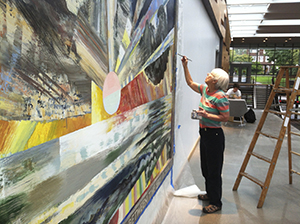
Artist Lucinda Parker ’66 adds the finishing touches to the installation of "Our Solo Round Star Squeezed Between the Sky and Sea" in Reed's Performing Arts Building. Chris Lydgate ’90
Reed has received a grant of $28,000 to acquire the painting Our Solo Round Star Squeezed Between the Sky & Sea by celebrated Portland artist and Reed College alumna Lucinda Parker ’66. This acquisition was made possible with the assistance of the Ford Family Foundation through a special grant program managed by the Oregon Arts Commission (OAC). “The college is thrilled to acquire such a substantial work of art by a distinguished alumna during an era of profound growth and innovation in the arts at Reed," says Cooley Gallery director Stephanie Snyder ’91. "Lucinda Parker is a visionary painter, and an integral part of the Reed community. Her work chronicles the living history and vitality of the Northwest with unmatched vibrancy.”
Our Solo Round Star Squeezed Between the Sky & Sea, completed this year, is a monumental acrylic on canvas painting, measuring 91 x 153 inches. Its particular subject matter and the circumstances of its creation are unique within the artist’s oeuvre. Parker created the work while an inaugural artist-in-residence at the Robert Rauschenberg Foundation Residency Program at the late artist’s Florida studio complex. During the residency, Parker spent an entire month observing and making small gouache studies of the sunset. Concurrently, she began working on this encompassing vision of natural rhythm and spiritual transformation. In her words: “The painting explores death and renewal—the mystery of where the sun goes when it disappears into the ocean—old myths.”
Lucinda Parker is one of the Pacific Northwest’s most significant and enduring painters. She is associate professor in painting and drawing, emerita, at the Pacific Northwest College of Art, where she studied fine arts in a dual-degree program with Reed, and an MFA graduate of the Pratt Institute. Her work has been shown at numerous institutions, including the Portland Art Museum, the Jordan Schnitzer Museum of Art, the Seattle Art Museum, and Marylhurst University. Her work is represented by the Laura Russo Gallery in Portland.
Continue reading "Star" Graces Performing Arts Building
Sketching Infinity
The universe of Vance Feldman ’05 explodes with jumbled houses, bridges and aqueducts, businessmen shaking hands, dolphins jumping out of rivers, and spacemen kicking their feet back in lawn chairs. To call his work monumental would be something of an understatement. Modestly titled the ForeverScape, his drawing rivals some of the longest art pieces in the world. Spanning roughly 650 feet from left to right—the equivalent of two football fields—the ForeverScape is assembled out of 700 sheets of letter-size paper and grows longer by the day.
The ForeverScape started in September, 2009, when Vance was in between jobs and found himself sitting in a bar with a ream of paper. He started aimlessly sketching a landscape and when the first page ended saw no reason to stop. The first couple hundred pages, drawn in ballpoint pen, feature a smoggy, industrial landscape littered with crowded buildings twisting into each other and spilling onto the road and barbed wire fences about to snag innocent hummingbirds. These give way to apocalyptic scenes of civilization being swallowed by the sea. Squid and clownfish lazily swim above a submerged city whose buildings are wreathed in slimy weeds and whose skyscrapers are tickling the belly of a whale. One scene depicts several men attempting to subdue and photograph what appears to be the Loch Ness monster. Later, after Vance switched to using a Sharpie, the sea becomes the sky and we zoom into a psychedelic rendition of outer space, filled with boats and clams and astronauts playing badminton in reclining lawn chairs.
The chairs pay homage to Prof. Michael Knutson [art 1982–], who once told Vance that all he painted for several years were lawn chairs. Prof. Knutson likes the piece so much that he shows it to his art classes every year. The ForeverScape demonstrates, he says, “an incredible imagination, focus and energy.” In a subtler way, it also evokes a childhood loss and a lesson Vance learned at Reed.
Continue reading Sketching Infinity
Restoring a masterpiece, solving a mystery
The New York Times ran a fascinating story this week about the restoration of a landmark painting by Jackson Pollock, One: Number 31, 1950. The piece explains how conservators at the Museum of Modern Art, led by Jim Coddington ’74, restored the giant canvas that the Times characterized as a “masterpiece of Astract Expressionism.”
As they began the painstaking work of removing decades of grime from the painting, Coddington and his colleagues made a shocking discovery: some areas of the canvas were marked by synthetic resin, a kind of paint that Pollock had not been known to use. Furthermore, the resin had been applied using a sort of brushstroke that was unlike Pollock’s style. As Coddington told the Times, the sections showed a “fussiness that has nothing to do with the way Pollock applied paint.”
The evidence strongly suggested that these portions of the canvas had been painted over by someone else, possibly in an attempt to cover up some small cracks. But how could he be sure?
Continue reading Restoring a masterpiece, solving a mystery
Lena's Paintings on Display
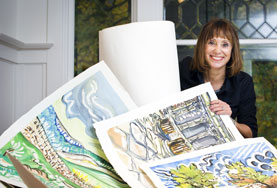
Professor, author, translator, traveler, collector, mentor, and—yes, artist. Welcome to the protean career of Lena Lenček, pictured here at home with a series of watercolors she painted on a sabbatical visit to Tuscany. Photo by Leah Nash
Recent paintings by Professor Lena Lenček [Russian 1977–] appear in Geochromes: The Spirit of Place in Line and Color, showing through June 2013 in the Vollum College Center Gallery. Stephanie Snyder ’91, director of the Douglas F. Cooley Memorial Art Gallery, is curator.
The exhibition features works that Professor Lenček created during 2011–13 in some of the world’s most magical environments, including Tuscany, Puglia, the U.S. Southwest, Baja California, and the Oregon coast. Lenček states: “I chose a cloistered profession, but I’ve lived my life on the move, anxious to see as much as my eyes will hold, and in this gluttonous curiosity, pen and paper have been my accomplices. I sketch on the road, the air, and the sea because only when I look with my pen and brush do I catch and fix the fleeting conjunction between the timeless geography of land and my moment and the memories to come.”
Continue reading Lena's Paintings on Display
Reedie Designs Sundial for Mars Rover
On a clear Southern California night, Tyler Nordgren '91 stepped outside to take a last look at Mars through his home telescope before stepping inside to watch the landing of the Curiosity rover on NASA TV.
By this time, Curiosity was already slamming into the Martian atmosphere at more than 13,000 miles per hour. After four minutes of aerobraking, the largest supersonic parachute ever deployed off the planet Earth slowed the rover to 220 miles per hour. Then the lander cut away from the chute, firing retro-rockets and searching for a good landing spot. Twenty-five feet above the Martian surface, the lander lowered the rover to the ground and fired explosives that cut the tethers that held them together.
Continue reading Reedie Designs Sundial for Mars Rover
Johnson Creek Art Show
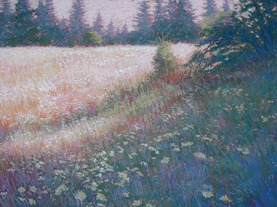
Gary Michael, Powell Butte, pastel
Reed is hosting a cool show of art inspired by Johnson Creek and its tributary, Crystal Springs, which issues forth from the Canyon.
Check out the art on display in Vollum Lounge until October 12, 2012.
Continue reading Johnson Creek Art Show
Synaesthesia and the Great War
"Today's dissonance in music and painting is merely the consonance of tomorrow," wrote Russian painter Wassily Kandinsky in a 1913 letter to Austrian composer Arnold Schoenberg. At the dawn of the 20th century, artists like Kandinsky and Schoenberg broke free from the norms of their medium--and subsequently, their era--by creating music and art that was atonal and abstract. But one year later, the entire movement was uprooted, and the daring avant-garde was replaced by the traditionalism of yesteryear.
What explains this artistic retreat? The Great War, according to author and musicologist Olivia Mattis, who visited campus Saturday as part of ROMP (Reediana Omnibus Musica Philosopha), Reed's annual symposium on music and the liberal arts. "The high modernism of the pre-World War I avant-garde was displaced" after the war, said Mattis. "War called for a return to traditional values."
Continue reading Synaesthesia and the Great War
Shipwreck in Eliot Circle
RAW is in the air. Since Wednesday morning, projects have been cropping up throughout campus, with concentric circles of laundry rising from the front lawn, surreal living rooms materializing in Commons, and rolling pallets of grass drifting around the ground floor of Eliot.
Today, a grubby crew of artists in sweatshirts and Carhartts could be seen industriously striding around Eliot Circle, stacking and welding several tons of scrap metal into a labyrinthine tower. The piece, entitled Assembly of Freight, is the brainchild of sculptor and installation artist Ben Wolf.
Continue reading Shipwreck in Eliot Circle

